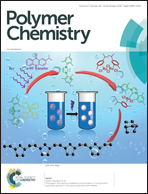Reverse-phase high performance liquid chromatography (RP-HPLC) as a powerful tool to characterise complex water-soluble copolymer architectures†
Abstract
Recent progress in modern polymer synthesis techniques has led to the design of complex functional materials, which can be difficult to analyse accurately. While size-exclusion chromatography (SEC) or mass spectrometry (MS) is typically used to gain information about molecular weight distribution, chemical structure and molecular architecture, there is a lack of available methods for characterising compositional heterogeneity (i.e. monomer distribution). In contrast to SEC in which separation occurs by hydrodynamic volume, interaction-based chromatography (IC) separates compounds according to their affinity for a stationary phase, which has proven useful in gaining information about the general chemical structure of copolymers in the past. Here, we explore the potential of reverse-phase high performance liquid chromatography (RP-HPLC) as a tool for the characterisation of monomer segmentation in charged water-soluble copolymers. A library of acrylamide copolymeric systems, prepared via reversible addition–fragmentation chain transfer (RAFT) polymerisation, is used to demonstrate the influence of monomer distribution (diblock, multiblock and statistical) on the elution time. The robustness of the method is tested by studying a range of copolymers with varying charges, charge contents and hydrophobicities, as well as by using various solvent systems or column lengths. Results highlight the efficiency of RP-HPLC to separate copolymers with varying segmentations, with a limitation observed for branched architectures.



 Please wait while we load your content...
Please wait while we load your content...